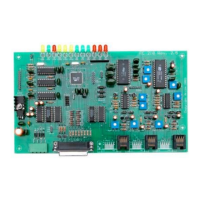32
The Scheduler
The Scheduler lets you automate many routine tasks by defining a specific day of the week, the hour of that day and the number of
minutes past the hour you wish that task to run. Such a definition is called a setpoint, which is programmed to run a specific macro at a
specific time of day. Only macros may be run by the scheduler, however that macro may contain any command(s), including speech
commands such as Time of Day.
Note: setpoints are one-shot events that occur only once at the scheduled time
One example of a setpoint would be if you wanted to link Port 1 to Port 2 for a net that lasts for an hour every Tuesday at 7 PM. You'd
define a macro to link Port 1 to Port 2, then define a setpoint to call that macro at 7 PM. After the net is over, another setpoint could be
defined to call a different macro that disconnects the ports.
How Do We Define Setpoints?
A programming commands allows us to program each setpoint by defining the time and day of week that setpoint should run and the
macro to be executed. The format is:
*4001 SS DOW Hours Minutes Macro
SS is the setpoint number 01-20 and must always be 2 digits
DOW is the day of week:
1 = Monday 6 = Saturday
2 = Tuesday 7 = Sunday
3 = Wednesday 8 = weekdays
4 = Thursday 9 = weekends
5 = Friday 0 = everyday
Hours and Minutes are the time in 24 hour format. For example, 10 24 = 10:24 am or 22 10 = 10:10 pm
Hint: The hours digits may be set to a wildcard value with a DTMF "0A". Setting the hours to "0A" causes a match every hour at "minutes"
after.
Macro is the macro to be executed at the appointed time and may be any macro you have defined 01-40. You must use 2 digits.
More than one setpoint can be run at a particular time. For example, if more than one setpoint qualifies at a particular time, the lowest
numbered one will be run first, then the next and so on. You can cancel any previously defined setpoint by setting it to a time that will
never occur, i.e 25 00 hours.
Recurring Voice Messages
You may want to define a setpoint that announces the time every hour (using the hourly wildcard) during morning commute time on
weekdays. Easy enough, we'll just program a setpoint to recall a macro that calls function 116 (Say Time), speak on Port 1 and call that
macro with a scheduler setpoint to run every hour, starting at 6 AM. The RC-210 will now speak the time every hour, on the hour. But
we have a problem now - there is no way to stop the hourly announcements without actually reprogramming that setpoint so that it
doesn't announce the time any more. Since the controller will now announce the time every hour, 24 hours a day, this obviously
doesn't work out the way we want!
So how can we stop that setpoint from continuing to run until we reprogram it? Without something to tell the scheduler to stop running
that setpoint, in fact we can't. So once started, the controller is going to announce the time every hour until we do something about it.
In order to get around this problem, the RC-210 incorporates another set of commands that allow you to suspend a currently occurring
setpoint without having to actually erase that setpoint. These commands are known as the Suspend and Resume commands. What
the Suspend command does is to prevent a setpoint from occurring by setting a flag. The RC-210's program then knows that since the
Suspend flag is set, it shouldn't continue to execute that setpoint. To start it running again, we simply use another setpoint to run
another macro that calls the Resume command. The setpoint to announce the time is now free to run once more.

